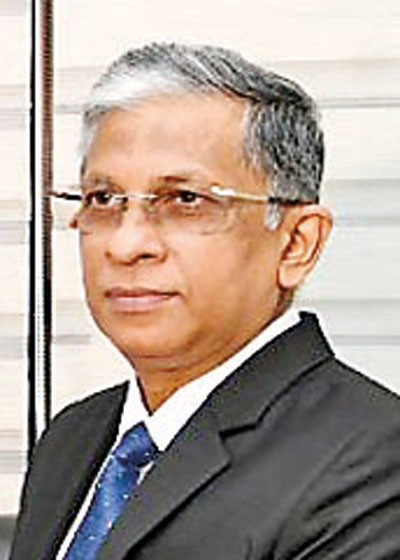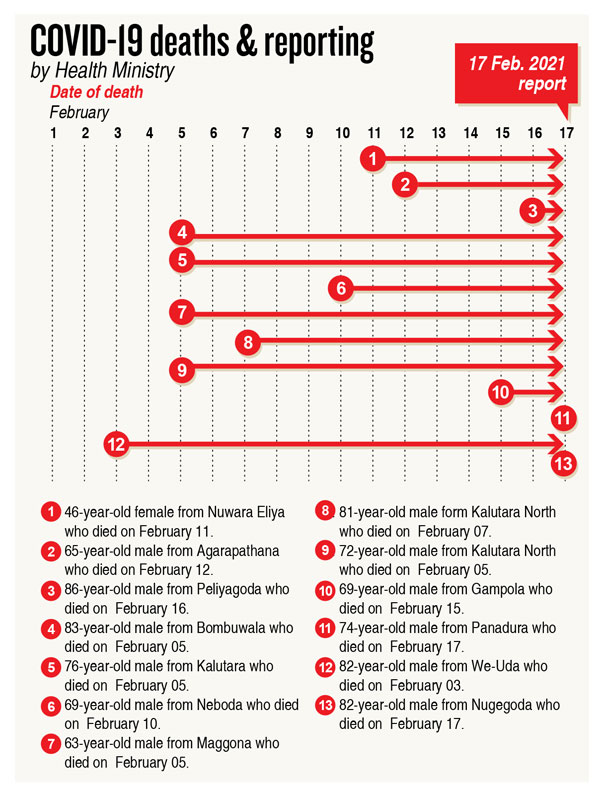News
Numbers reducing, but preventive measures a must: Health DG

Dr. Asela Gunawardena
In a one-on-one interview on Wednesday night, lasting more than an hour, the Sunday Times spoke to Dr. Gunawardena on a range of issues that people are grappling with, as the week also saw many new developments.
Allaying concerns that there would be tighter restrictions after genetic sequencing found the variant circulating in the United Kingdom and many other countries, here in Sri Lanka too, the DG appealed to people to follow the preventive measures scrupulously.
“This is the only way to contain any variant that may come about,” he stressed, explaining that hand-hygiene, mask-wearing, physical distancing and cough-and-sneeze etiquette, were the answers.
He said that gatherings, large or small, could easily lead to COVID-19 super-spreader events as people invariably remove their masks or wear them incorrectly when chatting or eating and drinking at such events. “We have not changed our guidelines but we also need strict supervision to ensure that the guidelines in place are followed. Even if there are 50 peoplegathered somewhere or even 10, it could become a super-spreader situation if masks are removed and physical distancing is not followed.”
The DG’s office is a good example of physical distancing. Not only is a large table between his chair and the visitors’ chairs, but the latter are also pushed back from the table to rest against the wall, while throughout the interview he wears his mask.
Taking countries such as New Zealand, Taiwan, Singapore and Japan, Dr. Gunawardena said that they have contained the virus to a certain extent by strict adherence to these preventive measures in a disciplined way on a personal as well as societal level.
When asked about the number of people affected by COVID-19, Dr. Gunawardena shows a graph on his mobile-screen and says there is a gradual declinein numbers now. The increase was due to the Christmas, New Year and Thai Pongal holidays when people travelled around and did not listen to healthcare workers. There were gatherings here and there and people travelled a lot, which obviously become super-spreader events.After the 14-day incubation period since the Christmas holidays came the positive cases somewhere around the middle of January and then another influx of cases after Thai Pongal in end-January, early-February.
“A small cluster of infections began within the garment industry at Mahiyanganayaand Avissawella. If there is one positive person in such a setting, it leads to another 100-200 cases, either going down a particular production line or even in the whole factory,” explained the DG.
Any moves to isolate asymptomatic positive people at home?
When asked whether there are any moves to isolate asymptomatic positive people at home, like it is done in many countries, he said that there were arguments for and against such a move.
While conceding that it was a huge logistical operation to transport all such patients to intermediate care centres (treatment centres), Dr. Gunawardena said that there were also risks of the virus spreading among the family if isolation was done at home and the positive people were not careful, leading to a rise in numbers.
“It is a very difficult ‘balancing act’ that we are performing but we continue to do so. Keeping the asymptomatic in intermediate care centres till the incubation period wears off has allowed us to contain the virus, otherwise there would be uncontrolled spread as in countries such as the United States of America and the United Kingdom,” he said, arguing that if 600-700 test positive a day and 10% do not keep to proper isolation when at home, there would be another 300 cases.
Are hospitals and intermediate care centresoverloaded?
The DG said that there are adequate beds at the intermediate care (treatment) centres, but they are keeping a close eye to ensure that the COVID-19 designated hospitals do not get inundated.
Highly symptomatic patients are sent to the National Institute of Infectious Diseases (NIID or Infectious Diseases Hospital – IDH) and the Colombo East (Mulleriyawa), Homagama, Iranawila, Kilinochchi, Kattankudy, Welikanda, Teldeniya and HambantotaHospitals.
The mildly-symptomatic and asymptomatic positive people are sent to intermediate care centres.
When asked about having COVID-19 wards in all major hospitals – a suggestion from healthcare staff to relieve the exhaustion of staff who have been treating COVID-19 patients for a long time and also ease up on the bed capacity of these hospitals – he said that then people with other diseases would suffer and there could be disastrous results.
“Eventually patients will not die of COVID-19 but of other diseases such as cancer, heart disease, etc. We need to be able to balance,” he added.
| DG refutes allegations of under-reporting of COVID-19 deaths When asked about allegations of under-reporting of COVID-19 deaths, DG Dr. Asela Gunawardena said there is no such cover-up. He explained that if a person dies at home and there are suspicions that it was due to COVID-19, an RT-PCR test needs to be performed on the deceased. Whatever a person has died of at home, the body of the deceased has to be taken to the closest hospital for an inquest. The Medical Officer of Health (MOH) and Public Health Inspector (PHI) of the area can make a call whether to do the RT-PCR or not. “If a person has been in home quarantine or has been exposed to the virus in some way, an RT-PCR should mandatorily be performed,” he said, pointing out that there could be a delay in getting the test results which in turn would cause a delay in releasing the body. Citing some examples, Dr. Gunawardena said that if the deceased is brought to the hospital in the afternoon, the RT-PCR test may not be done till the next morning. In the Colombo region, the test result may be released within 24 to 48 hours maximum, but in the periphery where there may not be many laboratories, it may take about 72 hours. As such, to confirm whether it is a COVID-19 death may take about three days. Once it is confirmed that it is COVID-19, will it be included in the death toll. “When you look at our statistics you can see that the date of death is also given. For deaths, there is a cumulative figure and not real-time data,” he said, adding that if an inquest has to be conducted sometimes the body may be kept for a week or two. The Sunday Times studied the ministry data and found that the DG was being factual. Delays in releasing bodies Dr. Gunawardena reiterated that the discretion of deciding whether the deceased has been exposed to COVID-19 has been given to the MOH and PHI – after determining whether the person was in quarantine or had contact with a COVID-19 positive case. If either of those two factors is present, an RT-PCR test is required. If the MOH/PHI can ascertain that there is no such contact history and the patient was having cancer or is a terminal patient, they can say that there is no suspicion of COVID-19. They can use their discretion. Then the GramaSevaka can follow up with the required paperwork, he said, adding: “We have sent these instructions clearly. The problem is that they are fearful about taking that responsibility.”
| |
| Burial vs cremation “The decision whether to allow either cremations or burials for the COVID-19 dead is pending and we even had a meeting this afternoon (Wednesday) about it. We are waiting for the Health Minister and her authority is final,” said Dr. Asela Gunawardena. The report of the Expert Committee headed by Prof. Jennifer Perera has been sent to the Technical Committee for their views, it is learnt. According to this report, cremation or burial could be allowed depending on the choice of the family/guardian. “Once the Technical Committee gives the final verdict, the Minister will take a decision,” said the DG. RT-PCR tests a huge cost If we can increase the number of RT-PCR tests, it would be great but it depends on the country’s resource availability, economy, etc., said Dr. Asela Gunawardena. He said: “People do not understand that it is a huge cost. Private hospitals charge around Rs. 7,500 for a test or even more. Usually, we doaround 15,000 to 19,000 tests per day inclusive of the 3,500-5,000 tests performed by the private sector. If calculated conservatively (at Rs. 6,000 per test) it costs Rs. 90 million per day for the average of 15,000 tests done by the state.” |



